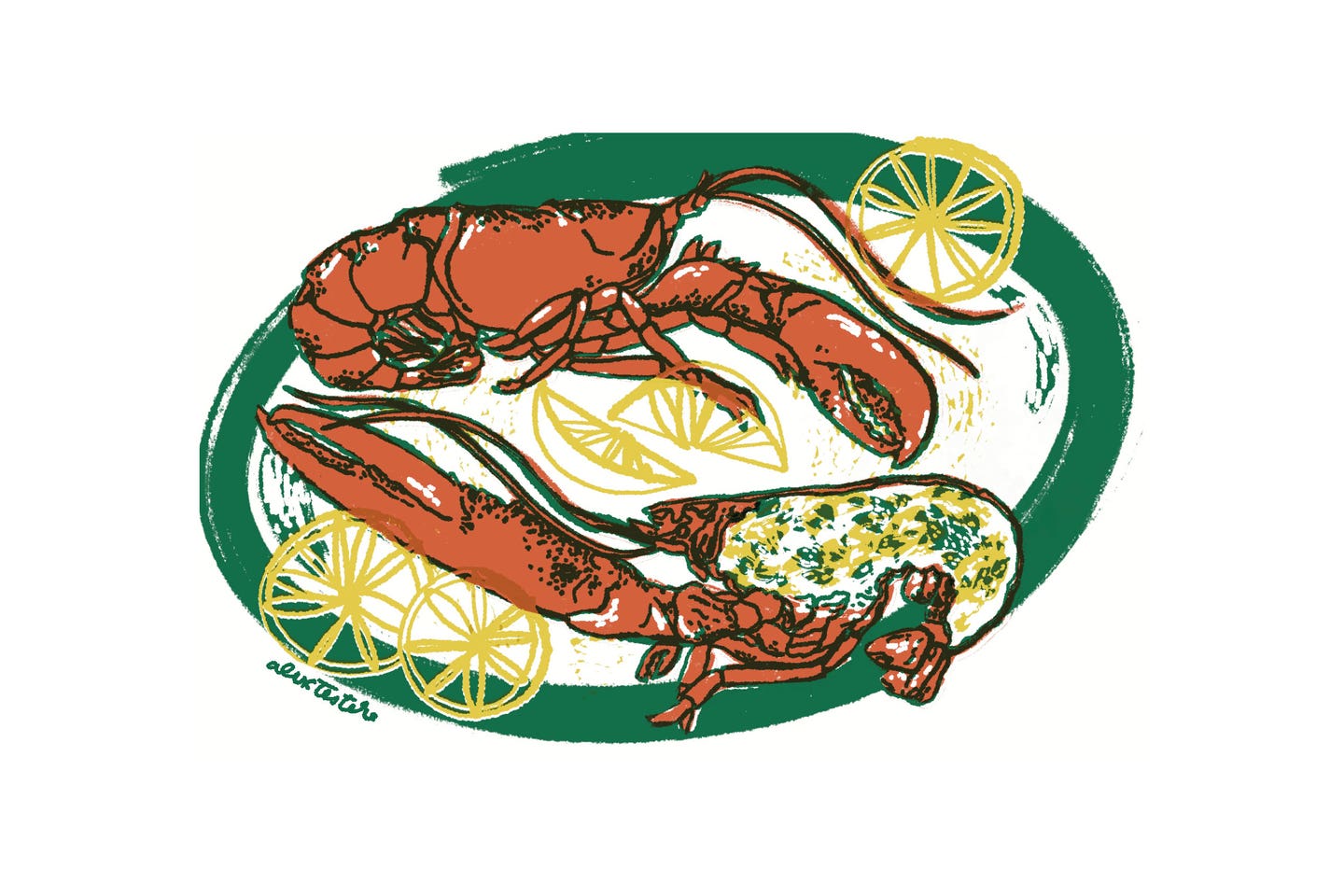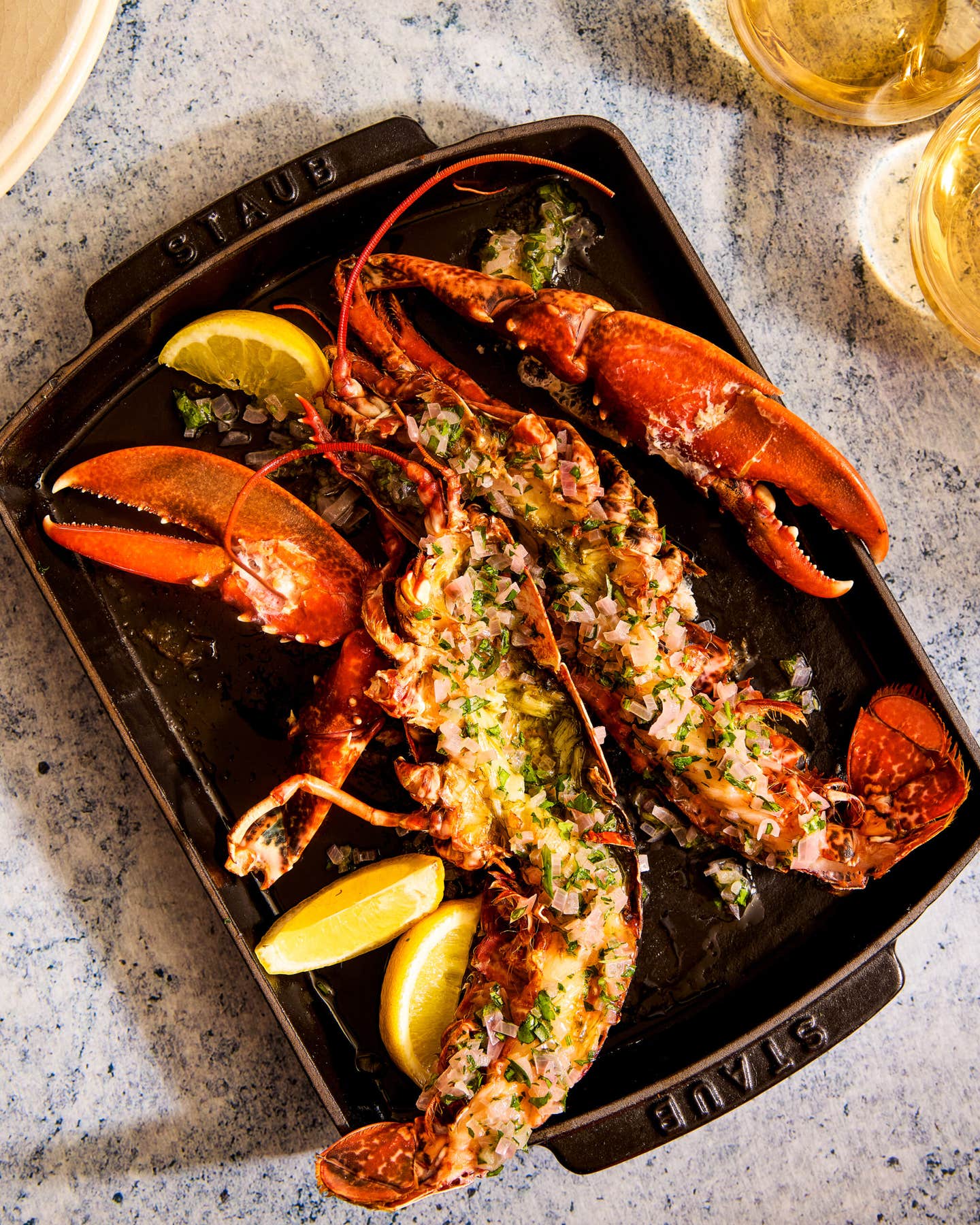
A Scottish Lobster Recipe That’s Worth the Wait
Peak-summer local crustaceans need little embellishment beyond a simple pan sauce in this cherished family dish.
When I was in my teens and starting my life as a chef in London, before adulthood’s small luxuries had come to roost, I arrived home to Dundee by train, the last few minutes of the journey spent barreling over the great Tay Rail Bridge spanning the vast estuary of the Firth of Tay. As the train rolled into the station, there stood Mum and Dad as always, all waves, hugs, and great excitement.
In later years, with my 20s behind me, and now a head chef in restaurants, I would splash out on a flight from London City Airport to the small strip on the north bank of the river, that bit further out from Dundee. The feeling was akin to that of an old film. As the twin propellers stopped turning, the falling silence was broken with whoops from folks waiting to scoop up their disembarking loved ones.
And then we were on the road home, to a house filled with the scent of a pan of lentil soup simmering on the stove, a loaf of bread still warm from the oven, and the memories of countless dishes prepared and scoffed at through our childhood that we now craved as grown-ups returning home. Drinks were poured amidst the bustle, chatter and all the usual hoo-ha coming home entailed, while Mum wove a path through it all, readying the table to feed her brood.
When the excitement had finally blown itself out—and between spoonfuls of our favorite brew, ladled from the great pan of lentils—talk turned to what was in the cards in the coming days. Visiting gardens, markets, and bookshops were mooted, as well as perusing the familiar bakers, butchers, and fishmongers. Was there anything new to explore? No, of course not, with many of the usual suspects still trading—if perhaps not thriving—as is the way on the east coast of Scotland, a place where the hands of time seem to turn so very gently.
At the forefront of the many thoughts and suggestions bandied ’round the table were those of lobster. Partly due to conscience, though mostly availability, I only ever ate lobster on these rare occasions while visiting my folks. These beautiful crustacea, caught locally, could only be had with a phone call first to make sure that the guests of honor were in the tank, abutting the pier in Crail on the East Neuk of Fife.
The prize lay at the end of a fair drive from the hills in Angus where we lived, across the River Tay from the county of Angus where lies the Kingdom of Fife, home to the ancient and venerable town of St. Andrew’s. Beyond the university and ruins of castle and cathedral sits the East Neuk of Fife, a coastline with small fishing ports once home to great fleets of trawlers that fed a vast herring trade. For the great part, the fisheries are the stuff of legend, the silver darlings now but memories. That said, the ancient, small, and rather lovely harbors remain—Anstruther, St. Monans, Pittenweem, and Crail—unchanged in appearance except for the lack of hubbub.
A modest but healthy fishing trade persists there, but always in Dad’s mind was the tank at the bottom of the steep road to the harbor in Crail. When the call was made to ensure lobsters were to be had, and a great “ah!” of success was uttered: The adventure began. For, yes, indeed, within the tank were lobsters, their shells of a darkly hued deepest indigo, their claws bound with rubber bands to prevent any untoward mishap befalling the unwary.
My parents loved these adventures, piling my sister and brothers into the car and heading off to find some marvel from among the many delights the east coast has to offer. Scotland’s seaboard has much to recommend: Its game, meat, fish, fruit, vegetables, and of course shellfish, add considerably to the magnificence of the local larder.
Lobsters acquired, Dad, ever a spirited driver, made for home. In the kitchen, potatoes were peeled and cut to fry golden and crisp. Wine was chilled. Was it warm enough to lay a table outside? Such thoughts I left to my folks, who had their ways, while I busied myself with the lobsters, each just shy of a pound in weight—the meat of slightly smaller lobsters always a bit sweeter and more delicate.
Necessity demands shellfish remain alive with vigor until just prior to cooking. I could pull a discreet veil over the dispatching of lively lobsters, but I prefer to be frank about the practicalities—a deft, swift piercing and confident downward thrust cleaves the crustacea in two and does the job. Then, with a flick of the knife inserted at the joint, the claws are detached and cracked, and the lobster is ready to cook.
Such purity of produce requires but the simplest of cooking. The parts are laid in a deep tray. Shallots are peeled and finely diced. The herbs are picked and finely chopped. Then the lobsters are lightly seasoned with sea salt and freshly milled pepper, anointed with olive oil, and roasted swiftly, before they are placed on a handsome dish. The sliced shallots are added to the still-warm pan over gentle heat. After a few minutes, the wine is added, and a minute later the herbs and lemon juice. The rising scent beguiled me, reminding me why I never ate lobster anywhere else but home in Scotland.
And even though a bowl of chips was served, they were often cool from neglect as every last morsel of lobster was picked from the shells, while chatter and wine flowed. My parents took affront at any such waste, this being a dish as cherished as these times at the table together.
Though I miss my folks hugely, I am blessed with friends who love to holiday on the Western Isles as much as I do and visit one of the Hebrides each summer. When fortune smiles and a fisherman lands his catch, and when the filled lobster creels and crab pots are decanted and we have chosen our beasties, we hurry home and set the fires to cook. While we feast splendidly on Scottish lobsters, I smile with old, happy memories of the east coast mingling happily with new ones made in the West.
Recipe

Keep Reading
Continue to Next Story










